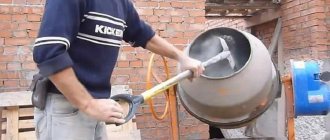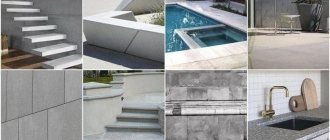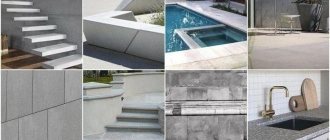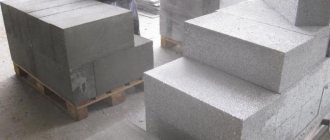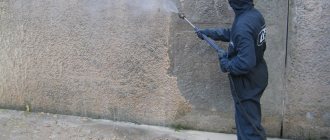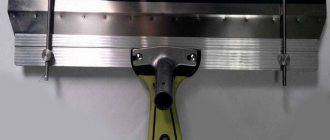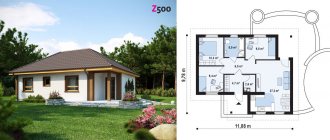Home |Types of concrete |What is glass concrete?
Date: October 18, 2018
Comments: 0
Traditionally, concrete is used as the main building material. We are used to this, and when we conceive a new project, we do not always study modern developments. Concrete is familiar and accessible. But there are situations in which it is worth paying attention to new products in the construction industry. These rightfully include glass concrete (glass-filled composite), the distinctive feature of which is increased tensile strength. This makes concrete structures much stronger. But to figure out which glass concrete option you should choose, familiarize yourself with the distinctive features of each type.
It's hard to believe that broken glass can look so beautiful
Nowadays, many people are interested in making various items for home and garden from cement. This material is inexpensive, and the technology for using it for household needs is very simple. Large flowerpots and flower pots of various sizes are the most popular DIY items. But what to do if the natural gray color of cement seems boring, and coloring it “cheapens” the appearance of the product? Try an original technique that will give the surface a stylish, original and not at all boring look!
Take bottles (can be of different colors), wrap them in several layers of paper and thick polyethylene. Using a heavy hammer, break and crush the glass. Be very careful! You don't want to hit it too hard - you want small pieces, not just glass dust. It is best to pour the fragments into glass jars and close them with lids for safety.
The shape for the future product can be plastic pots and buckets. For each flower pot you will need two containers: an outer one and an inner one, and the diameter of the inner one should be at least 2 cm smaller. In addition, to prevent the inner container from floating, you need to pour stones into it.
To make cement mortar (for two small pots and a stand), you will need 0.5 kg of pure cement, 0.5 kg of cement adhesive mixture for gluing tiles, and the same volume of fine sifted sand. Mix the dry ingredients thoroughly and then, while stirring, gradually pour in 400 ml of water.
Pour broken glass into the mixture in the same volume as sand. Mix the mixture thoroughly again. Let the mixture stand for 15 minutes.
To prevent the cement from sticking to the molds, they need to be lubricated with ordinary vegetable oil.
Spread the cement paste into the outer molds and shake or tap them on the surface to release any air bubbles. Then carefully “screw” the internal forms into the cement mass. Make sure that the edges of the future pot are the same thickness. Leave the pieces to dry for 48 hours.
After this, pour out the pebbles that weigh them down from the inner molds and carefully remove them. Pour water inside the cement pots to wash away the grease. Turn the outer mold upside down into a basin and squeeze out the cement blanks. Leave the resulting products to dry for another 24 hours.
After this, the pots will have to be sanded. Use coarse sandpaper first, then medium sandpaper and finally fine sandpaper. Products must be sanded in water. When you remove the surface layer of cement, you will see how beautifully pieces of glass appear.
Let the pots dry again and coat them inside and out with a layer of water-based acrylic varnish. This will make them waterproof.
Luxurious pots are ready and you can plant plants in them!
Even more details and details of the process of creating glass-concrete pots are in the video below.
Source
Installation for the production of building heat blocks
Calls from all Russian phones are FREE! CALL! 8-800-775-15-13
And the installation for the production of heat blocks will help you make heat blocks!
You can produce blocks for your home in 10 days! And fold it in 10 days!
I was worried about ordering something on the Internet, but no one demanded advance payment, but I paid upon receipt, everything that was promised was inside. This is the first thing.
Secondly, in the garage, which was standing idle, I began to little by little produce blocks, although slowly but surely everything is working out.
Then I advertised for free on Avito, and started selling, a little is not enough, but I get 2-3 average salaries in our city, and I’m thinking about hiring
workers... I am making far-reaching plans with you, thank you!
27 secrets of saving on a construction site: How to make sure that you are not shortchanged, deceived or robbed by builders and schemers How to quickly make a house project (for yourself and the client), secrets of calculating coverings, ventilation, communications How to extend the life of a concrete mixer by 8-9 times How to make blocks in any weather How to use a heat block to save 6-10 times on a construction site and build a house 10 times faster How to double the area of a house almost for free (secrets of the attic) How to calculate a convenient staircase How to heat a house cheaply without gas How to make a mini-lift at a construction site
Is it possible to add glass, construction waste, and wood waste to concrete for volume? How will it affect it?
If we put it this way, when pouring a foundation where large masses of concrete are required, add additional glass, construction waste, and wood waste, how will this affect the quality of the foundation and concrete as a whole. Has anyone encountered such technologies and where can I learn more about them? ECO.
Hello, this is indeed acceptable as a filler and reduces the cost. You need to exclude the tree - this is not compatible. The main thing here is adhesion - compatibility of materials, and regarding ECO, if the brick is not from Fokusima, then it is possible.
Glass, unfortunately, is not suitable as a filler (without special processing and preparation), the ASR reaction (alkali silicate) results in uneven expansion and cracking of cement stone in the future. You can fill the provided voids in already hardened concrete with garbage, or alternatively, pack it in plastic and embed it in a monolith in the manner of amphoras (the voids thus lightened the walls and, with thoughtful use, the structural properties satisfied the requirements) in the case of sawdust for thermal insulation, but you need to keep in mind the properties and the behavior of such fillers even in voids. It is better not to add anything like this to concrete during production, and even the water should be drinkable and of normal hardness.
Concrete is an important component of any construction project and every builder should pay great attention to the process of preparing concrete and pouring it. The addition of glass, garbage and construction waste, as well as waste that consists of wood, will cause the strength of the concrete to suffer. You can add slightly medium-sized stones and reinforcement to the concrete composition.
Advantages of using liquid glass for concrete waterproofing
Among the main arguments in favor of using liquid glass for waterproofing concrete are the ease of use of the additive and low cost compared to other technologies. In addition, it is worth noting:
- the ability to provide reliable adhesion even to a mirror surface;
- the formation of an impenetrable molecular structure for the penetration of air or moisture;
- antibacterial effect (bacteria and fungi do not multiply on surfaces, the likelihood of which increases with increasing humidity);
- environmental safety of materials.
The surface coating is durable provided an integrated approach is taken. It is combined with additional measures for waterproofing the monolith. Experienced craftsmen use penoplex, roofing felt, and bitumen mastic for mechanical protection of the film.
Glass concrete manufacturing technology and areas of application
Glass concrete was developed about half a century ago and is currently a real competitor to reinforced concrete. Glass added to the concrete mass can significantly improve performance characteristics, incl. tensile and bending strength, which eliminates the need for heavy structures. Such reinforcement expands the possibilities of using concrete in adverse conditions.
When, by whom and why?
Pouring any formwork with concrete creates a very durable structure with a very long service life. The initial plasticity of the material and maximum strength after hardening make it very popular in the construction market around the world.
But among the many advantages of concrete, it has several disadvantages. The main one is the external unattractiveness of the resulting surface. Due to their dullness, concrete surfaces require mandatory decorative finishing.
Who invented transparent concrete and when?
In 2001, Hungarian architect Aron Loskonsi looked at the problem of concrete surfaces from the inside. He decided that the external unattractiveness of concrete could be corrected not by external decorative materials, but by changing its internal structure. As a result of a series of experiments, a new, technologically advanced building material was born - transparent concrete.
Hungarian architect Aron Loskonshi with his invention - transparent concrete
Transparent concrete, which has a very attractive appearance, did not immediately gain popularity. It was first used as a material for the construction of parts of buildings and structures in Europe, in Germany in 2005.
Transparent concrete blocks arrived in Russia in 2012. And in our country its use is quite limited. There are no domestic analogues for this material, and importing it from abroad is quite expensive. The price of a block weighing 10 kg is about 600 euros excluding delivery and customs duties.
For what?
The transparency of litracon is quite relative. In terms of light transmission, it is difficult to compare with glass. However, using blocks to build walls or partitions can significantly reduce the amount of electricity consumed by allowing natural light into the room.
At the same time, you will not be inside a glass cube; the translucent blocks retain a certain intimacy: through the litrakon wall you can only discern a silhouette or guess the color - provided that there is independent lighting.
On a note! The thickness of a block or panel of transparent concrete does not in any way affect its light transmittance. The main condition for the manifestation of this effect is the presence of a light source.
Difference in light transmittance of Litracon concrete and ordinary glass
Production technology
Glass concrete is a fairly large group of building materials in the form of concrete with glass or fiberglass fibers. Depending on the structure of the glass component and the method of its introduction, there are main varieties of this material.
- Glass reinforced concrete or composite concrete. Essentially, it is reinforced concrete in which steel reinforcement is replaced with fiberglass.
- Waterproof concrete with silicate additive in the form of liquid glass.
- Glass fiber reinforced concrete containing glass fiber as a filler, resistant to alkalis.
- Fiberglass-optic concrete or Litracon, characterized by relative transparency (translucent) due to the introduction of glass optical fibers.
- A mixture filled with glass chips (crushed glass).
- Acid-resistant concrete in which a glass component added to the solution acts as a binder.
In all of these varieties, concrete contains glass in one form or another. As a result, the structure of the material and its most important characteristics change. Glass concrete is sold ready-made and can be made by hand.
DIY production
Glass waste is difficult to dispose of and is poorly affected by the environment and microorganisms. Therefore, it is important to use waste material as recyclable materials for the manufacture of construction products. The technology for producing glass concrete from such waste is simple. First, start cleaning and sizing the filler and binder material. Using a high-strength grade of cement, they proceed to mixing the components. Silicates can be used as a binder.
Advantages and disadvantages
Glass concrete has a number of noticeable advantages compared to traditional concrete.
- Weight loss. When introducing glass filler, the content of cement and sand decreases, and since Since fiberglass is lighter than these ingredients, the weight of the starting material is reduced. This advantage is especially noticeable in the reinforced version, intended to replace reinforced concrete. Fiberglass reinforcement is much lighter than steel reinforcement.
- Strengthening. Glass additives significantly increase tensile strength (2.5 - 3 times), compression and bending. The impact strength of concrete increases by 14-16 times.
- Reduced thickness when replacing concrete products. Reinforcing glass fibers have a smaller diameter compared to steel reinforcement with similar strength, which makes it possible to reduce the thickness of the product without compromising the strength characteristics.
- Moisture and water resistance. Any glass fillers (especially liquid glass) increase the water resistance of concrete.
- Improving thermal insulation characteristics.
- Expanding the areas of application of the material. Glass filling makes it a universal building material with increased strength, waterproofing and thermal insulation characteristics.
Fiberglass concrete has virtually no significant disadvantages. Of course, the need to prepare a glass ingredient complicates the solution preparation technology, but the resulting advantages compensate for this disadvantage. In the process of preparing the material, you have to deal with glass dust, which requires careful protection of the human respiratory system. There is an accelerated hardening of glass concrete during the application process, which requires rapid use of the solution.
Main types of materials
Let us immediately note that the concept of glass concrete refers to a whole range of variations; we will not consider all of them; we will only get acquainted with those that are most often used and with which you can work independently. Each type has its own characteristics, which determine certain properties of the material.
Composite concrete
The second name for this option is glass-reinforced concrete. It is very similar to conventional reinforced concrete options, but glass concrete technology involves the use of fiberglass rods instead of metal reinforcement.
To explain all the advantages of composite reinforcement, let’s compare it with conventional metal reinforcement:
| Metal | Fiberglass |
| When exposed to moisture, it corrodes, causing the frame to collapse, reducing the strength of the concrete structure. | It is absolutely not afraid of moisture and can withstand its effects for a long time. |
| The large weight of metal-reinforced structures imposes many restrictions on construction. | Products made from glass concrete weigh much less, as a result of which they can be used almost anywhere. |
| The fairly high cost of the fittings makes the project much more expensive; in order to achieve high quality, you need to spend significant amounts of money. | The price of composite reinforcement is much lower, which makes it more affordable than conventional metal. |
| The weight of the metal is quite large, which creates inconvenience during work and loading and unloading operations. | Fiberglass rods weigh 5 times less with the same diameter. |
| Transporting reinforcement is very difficult due to the large length of the elements. You have to hire freight transport. | The material is rolled into coils about 100 meters long, and the weight of one coil does not exceed 10 kg. It can also be transported in the trunk of a passenger car. |
| The metal has high thermal conductivity, as a result of which the rods serve as unique cold bridges in the structure. | Fiberglass conducts heat 100 times less than metal, such structures are much warmer. |
Such reinforcement is superior to metal in all respects, which is why it is very widely used in modern construction
Another important advantage is that composite rods are 2.5 times more tensile strength, which allows the use of products of smaller diameter without losing the strength characteristics of the structure.
Work on creating a reinforcing belt of this type is much simpler and faster due to a number of reasons:
- Light weight material.
- Easy connection - using plastic clamps that securely fix each node.
- In winter, metal is very cold, while fiberglass does not freeze.
The work of laying a composite armored belt is much simpler than when using metal
Important! It is worth remembering that the strength properties of fiberglass are much higher, so you can use reinforcement of a smaller diameter without losing strength.
Glass reinforced concrete
This glass concrete has a number of differences, the main one of which is the use of fiberglass as a filler, which determines the high performance properties of the material.
Fiberglass is resistant to alkalis and other adverse influences
The main advantages of this option include the following factors:
- Versatility : this way you can make both panels and blocks or light and durable cladding sheets. The scope of application is very wide.
- Lightweight : the composition includes fine-grained concrete mixed with sand in a 50/50 ratio and chopped fiberglass.
- Strength of fiber-reinforced concrete: it is twice as resistant to compression as ordinary concrete, 4 times stronger in tension and bending, and impact resistance is 15 times higher.
- With the help of various additives: plasticizers, dyes, water repellents, the properties of concrete can change significantly.
But it is worth noting that the production of such material is a rather complex process, and high quality and reliability can only be achieved in a factory environment.
Fiber-reinforced concrete sheets have a unique structure and can even be used as a final finish
Technological features
Different types of glass concrete have their own production nuances.
- Water resistant. Liquid glass is used for production, i.e. sodium silicate. First, an ordinary concrete solution is prepared. Then, liquid glass is added to it at the rate of 100 ml per 1 liter of solution (excluding water). It is important to remember that increasing the amount of sodium silicate leads to increased fragility of the material and rapid hardening of the solution.
- Production of glass fiber reinforced concrete. Composition: cement, sand and glass fiber in equal proportions. It is important to distribute the fiber evenly throughout the entire volume, and mix the ingredients in a dry state. When applying the solution, careful vibration compaction must be performed.
- Filling with broken glass. Broken glass replaces crushed stone (from 25 to 100 percent), as well as partially sand. The production of concrete includes several stages. First, glass waste (waste) is crushed. Then, using a screen, the raw materials are sifted and divided into fractions. Splinters larger than 4 mm are intended to replace crushed stone (filler). Smaller particles are suitable instead of sand. This circumstance is taken into account when mixing the solution.
- Using glass as a binder. In this case, finely crushed glass is used, but it will not bind cement without additional processing. Glass performs this function when soda ash is added. During the reaction, it dissolves to form a silicate gel, and this holds the composition together. This produces concrete that is highly resistant to acids.
Recommended proportions
When mixing a mortar containing cement and liquid glass, the proportions recommended by building regulations should be strictly observed. The ratio of silicates to other components depends on the area of application of the solution. For information on the composition of an ideal floor screed, watch this video:
Waterproofing device
Waterproofing the walls and floors of basements and ground floors using silicate solutions is used in cases of high groundwater levels or in the absence of a reliable drainage system around the house. In this case, soil moisture can penetrate into the basement through pores and microcracks in the concrete, creating dampness there.
In order to prevent this, it is recommended to plaster the internal walls with cement-silicate mortar.
Silicate is mixed with sand and then added to the concrete mixture.
To do this, take 1 part of cement and add 2.5 parts of sifted sand to it. After this, we take liquid glass in a volume of 1/6 - 1/7 of the volume of cement. That is, if 10 kg of cement is used to prepare the plaster mixture, about 1.5 liters of liquid silicate are required.
Silicate easily dissolves in water; you just need to mix them thoroughly using a construction mixer. Pour cement and sand with the resulting water-silicate mixture and stir until you get the consistency you need.
To waterproof concrete walls of swimming pools, water wells or sewers, you need to prepare a coating solution with a significantly higher silicate content.
To do this, take cement and sand in a ratio of 1 to 1, and to them should be added liquid glass in the same volume and diluted in water.
The resulting mixture should be quite plastic and have a consistency similar to liquid sour cream.
The table shows the recommended ratio of components for waterproofing various structures.
| Purpose | Cement, parts | Sand, parts | Liquid glass, parts |
| Waterproofing wells | 1 | 1 | 1 |
| Standard waterproofing | 4 | 4 | 1 |
| Primer screed | 0 | 1 | 1 |
| Refractory mixtures | 4 | 1,5 | 1,5 |
| To fill voids | 3 | 1 | 1 |
| Waterproof plaster (for external use) | 1 | 2,5 | 0,5 |
Application of silicate-cement waterproofing is carried out in two stages. Initially, the surface to be plastered should be covered with one or two layers of clean liquid glass. To apply it, use a brush or brush with hard bristles. After the applied layer has completely dried, we begin applying the plaster solution.
It should be remembered that silicate solution has a very limited use time. Therefore, it should be prepared immediately before application to the surface to be plastered.
Thermal protection device
Liquid silicate added to concrete will enhance its fire-resistant properties.
When liquid silicates are combined with cement mortars, a material with remarkable fire-resistant properties can be obtained. Ordinary concrete begins to lose its strength and monolithic integrity when its temperature rises to 200 - 300 °C.
Liquid silicate added to concrete in a proportion of ¼ - 1/3 of the volume of cement significantly increases its fire resistance. Thus, heat-resistant concrete prepared in accordance with all building standards can withstand temperatures of up to 1000 °C or more without any negative consequences. To see what properties liquid glass imparts to screed, watch this video:
Such concrete is used in the construction of industrial facilities in the metallurgical industry. In private construction, fire-resistant compounds can be used when laying heating stoves and fireplaces, building chimneys, lining hot water boilers, and plastering heated surfaces.
Fire resistance in this case is ensured by the crystal lattice of frozen silicates, which does not allow the other components of concrete to deteriorate.
Areas of application
Glass concrete is widely used abroad in the construction of various objects. In Russia, the material is still used less frequently due to production problems, but its popularity is constantly growing. The following main areas of use of this material can be distinguished:
- Cladding of buildings. Glass concrete can be used in the form of finished panels or applied as decorative or protective plaster. Material with the addition of liquid glass is widely used in the construction of private swimming pools and other artificial reservoirs.
- Construction of walls and ceilings. Walls are made by pouring into formwork or using blocks (similar to cinder blocks). In the manufacture of floor slabs, the material replaces similar products made of reinforced concrete.
- Decorative design of facades. Building materials with optical properties are especially valued.
- Production of paving and curb slabs.
- Landscape design. Small architectural structures are made from glass concrete. In particular, the construction of arches, fountains, garden statues, and lighting poles is popular.
- Fences and bars. The high strength of the material provides reliable supports for fences, as well as the casting of decorative grilles and fences.
Glass concrete is also used quite actively in mass construction, incl. industrial buildings. Paving slabs have high wear resistance, which makes them suitable for use in parks.
The material is even used in the construction of bridges. It can be classified as a modern, high-strength building material. It is actively used instead of concrete products in the repair and construction of various types of structures. Some materials can be prepared with your own hands, which reduces the cost of construction and expands the possibilities of application.
Source
Traditionally, concrete is used as the main building material. We are used to this, and when we conceive a new project, we do not always study modern developments. Concrete is familiar and accessible. But there are situations in which it is worth paying attention to new products in the construction industry. These rightfully include glass concrete (glass-filled composite), the distinctive feature of which is increased tensile strength. This makes concrete structures much stronger. But to figure out which glass concrete option you should choose, familiarize yourself with the distinctive features of each type.
Technology for treating concrete bases with liquid glass
To cover a surface with liquid glass, you do not need to carry out technologically complex operations. But the result depends on the quality of the materials. It is worth making sure that the packaging with liquid glass is sealed, the additive does not contain lumps, is translucent, and has a gel-like consistency.
If the additive is subjected to freezing and subsequent thawing several times, it completely loses its properties. In order for the result to meet expectations, it is important to pay attention to the preliminary preparation of the base (cleaning it of formed deposits), eliminating cracks, and leveling.
External processing
Application to the floor or walls requires diluting the additive with water 1:10. This composition penetrates 2-5 mm into the base (the depth is determined by the condition of the structure and the number of pores). Processing is carried out in 3 stages. As a result, the impregnation forms a waterproof film on the surface. All existing defects and pores are closed by a monocrystalline mass. But impacts can cause damage to the coating, so additional protection is needed.
Painting with silicate mixture is possible. This treatment of concrete with liquid glass is carried out with special paints or self-prepared compositions.
In the second case, pigment is added to the additive, but as a result of a chemical reaction, the color loses its saturation. Therefore, to obtain a decorative effect, it makes sense to purchase professional materials.
Varieties
Depending on the form in which the composition is modified by glass, glass concrete can be of the following types:
- glass reinforced concrete;
- composition with the addition of liquid glass;
Glass concrete is a very flexible, elastic and high-strength material, which, while remaining concrete, is nevertheless unusually light
- glass concrete with fiber;
- translucent array with optical fiber;
- composition with broken glass;
- a solution where glass is used as a binding element.
Material composition
The internal content of the glass concrete mixture serves as a criterion for classifying types of material. To prepare a composite, it is necessary to modify the classic cement-sand mortar with additional substances:
- glass fittings;
- sodium silicate;
- fiberglass;
- glass waste;
- special fiber;
- connecting element - glass.
There are 6 types of glass concrete mixtures on the building materials market.
Advantages
Due to the use of special fillers, glass concrete is superior to traditional concrete. Main advantages:
- Reduced weight, since the main fillers - cement, fiberglass, sand - are mixed in equal proportions.
- Increased strength, since the glass-filled composite is characterized by increased resistance to deformation, and the impact resistance parameters are fifteen times higher than the characteristics of concrete mortar.
- Expanded scope of use and wide range of products made from concrete with glass filler.
- A significant number of possible additives that have a diverse effect on the characteristics.
Installation of panels and blocks
Translucent concrete blocks or panels can be used to finish facades and to form internal surfaces. The blocks are laid on a binder cement-lime mortar, or using adhesives based on epoxy resins and quartz flour. The strength of the resulting walls is not inferior to concrete masonry, and meets all the requirements for load-bearing elements of the building structure.
Panels made of transparent concrete are mounted on a frame or with anchors. Their design is similar to the technology of ventilated facades. The panels can also be laid as flooring. The strength of the material does not depend on the thickness of the tile.
The photo clearly shows that panels of transparent concrete blocks are mounted on a metal wall frame
Glass reinforced composition
Fiberglass reinforced concrete is essentially similar to reinforced concrete. It uses fiberglass reinforcement instead of metal. Based on this difference, the advantages are clearly visible:
An alternative to concrete is glass concrete, which has greater strength, frost resistance and thermal conductivity.
- light weight. The use of composite concrete significantly reduces the load on the foundation;
- does not freeze at low temperatures, which makes construction work easier in winter;
- affordable price.
Concrete with liquid glass
When carrying out construction in regions with low groundwater, it is recommended to use a composition with the addition of liquid glass to fill the foundations. The antiseptic properties of silicate glass make it possible to use it in the construction of wells, swimming pools and other artificial reservoirs. High heat resistance makes it possible to use it in the construction of stoves and fireplaces.
Liquid glass is used in two versions:
- The most efficient method is to dilute the glass with water and mix the ready-made solution with concrete. If undiluted glass is introduced, it causes cracks to appear on the top layer.
- In the second option, glass is used as a primer. It is applied to the finished block. If you apply another thin layer of cement with glass on top, the product will be reliably protected from moisture.
When preparing such a concrete mixture, keep in mind that it hardens quite quickly. Prepare the solution in small portions so that you have time to use it without waste.
A property common to all glass concrete is concrete to which glass in different forms is added as an integral part.
Liquid glass for concrete: instructions for use and preparation of the mixture
You can prepare a mixture of cement and liquid glass even at home, while observing a number of requirements. Violation of the mortar manufacturing technology can lead to the formation of cracks in concrete.
Liquid glass should be added to the dry mixture. To do this, first combine all the dry ingredients in the required proportions and mix them thoroughly without using water. Then liquid glass, previously diluted with water, is gradually poured into the composition.
It is necessary to strictly observe the ratio of all ingredients when preparing the solution in accordance with the recipe used for a specific type of work. For example, if we are talking about the amount of glass in concrete, then it should not exceed 25% of the total weight of the mixture. To prepare a primer using a cement composition and silicate glue, the ratio can be 1:1.
It should be taken into account that it is liquid glass for concrete that accelerates the speed and density of hardening of the solution. The instructions for use recommend preparing the mixture in small quantities and using it quickly.
To waterproof the concrete surface, liquid glass is applied in several layers
The setting time depends on the amount of liquid glass added to the concrete. If the mixture contains 2% of this substance, then it begins to set within an hour, if 5%, then after 40 minutes. The hardening process also depends on the proportion. If more than 4% silicate glue is added to the solution, the strength of the concrete after complete hardening will decrease by about 25%. However, if the concrete contains only 3% liquid glass, the strength of the structure will increase.
Helpful advice! Sodium silicate, in addition to its waterproofing function, has antibactericidal and antifungal properties. The chemical composition of the material is an unsuitable environment for the development of any life.
Technological features of the mixture and types of impregnation of concrete with liquid glass
Liquid glass in a solution mixed in M400 cement at a temperature of 20 ° C begins to set after 2-3 hours, and completely hardens within a day. Over time, the monolithic base will only become stronger. The maximum hardness effect is achieved after a maximum of 4 weeks. Liquid glass is also used as an impregnation of various surfaces, ensuring their smoothness, evenness and waterproofing. Treatment of concrete with liquid glass is carried out for the following structures:
- concrete floor;
- flat roof;
- wells;
- swimming pools;
- basements;
- plinths;
- concrete walls and ceilings.
After the liquid glass dries, all pores in the concrete become clogged.
The impregnation process includes several stages. First of all, preparation of the base is required. To do this, the surface is thoroughly cleaned of old coating, paint, debris, dust and dirt. Next, the surface is cleaned with a metal brush and the base is covered with a 2 mm layer of bitumen emulsion. The base is given time to dry.
Then the surface is impregnated with a solution of liquid glass. The proportions of liquid glass in concrete depend on the type of surface (in accordance with the instructions for use). If the surface is horizontal, then a layer of 2-3 mm is applied to it and the mixture is smoothed with a spatula. The floor and ceilings are poured in several layers, taking a break for a certain number of hours. The surface can be used after a couple of days.
During work, you need to adhere to a number of recommendations. In particular, the solution must be distributed evenly. The coating should be done as quickly as possible, without allowing the composition to harden. Reliable impregnation is ensured by applying the mixture in two or even three layers. To insulate walls and ceilings, use a special spray bottle, which promotes uniform distribution of the solution. Cover the surface in two or three layers.
Composite with fiber
Fiber is alkali-resistant fiber. An additive to concrete increases strength characteristics and provides decorative properties.
Depending on the type and amount of additives, the properties of glass fiber reinforced concrete change, but remain unchanged:
- moisture resistance;
- increased impact strength;
- frost resistance;
- light weight;
- resistance to chemical reagents.
Concrete composition with optical fibers (litracon)
The main ingredients and fillers of the array are optical fibers made of glass of increased length. When forming the composition, the fibers chaotically reinforce the block, and after cleaning the ends, they allow light to pass through unhindered. The ability of an array to transmit light depends on the concentration of fibers and the degree of color rendering of the material.
The material has an increased price, but work is underway to reduce it. The use of litracon in private settings is limited to the decorative functions of the composite, and not to its use as a building material.
Liquid sodium silicate (less commonly potassium) glass is added to concrete to increase resistance to moisture and high temperatures and has antiseptic properties.
Technologies of use
A detailed study of the instructions for using liquid glass for concrete allows you to avoid mistakes when using the composition. The consumption of the composition depends on the specifics of the measures to strengthen concrete with liquid glass.
Concretes with silicates
To properly prepare the working mixture, you should know how much liquid glass to add to the concrete. The amount of silicate additives should not exceed 5% of the total mass of the solution, which also includes water, cement, sand and crushed stone. Cement grade – not lower than 32.5 (M400).
It is important to know how to use liquid glass for concrete: it cannot be added to the finished solution. The technology requires mixing sand with cement, dissolving the silicate additive in water, then mixing the concrete, adding crushed stone. Since the mixture sets quickly, it should be used immediately and the container in which the concrete was mixed should be washed.
Primer
Priming the interior surfaces of swimming pools, septic tanks, wells, flooded basements and tanks helps protect structures from moisture damage. At the same time, existing defects and cracks are sealed. Using liquid glass for cracks in concrete allows you to create a reliable barrier against leaks.
Composition for the primer: a silicate composition is added to a mixture of sifted clean sand, Portland cement M400 and water. The mass proportion of liquid glass and cement-sand mixture is 1:1. To apply liquid glass to concrete, use a spatula.
Ironing
Ironing concrete with liquid glass means treating structures in order to increase the strength and durability of the top layer and increase resistance to mechanical damage and abrasion.
The prepared solution is applied to the concrete surface with a spatula or trowel and evenly distributed over the entire area. After drying, polishing is performed with a grinding machine. Lithium silicate is best suited for iron plating.
Waterproofing
Technology of using liquid glass for concrete waterproofing:
- Before covering concrete with liquid glass, protruding irregularities are removed from the treated surface, debris and dust are removed.
- Next, the surface is primed - to dilute the liquid glass to impregnate the concrete, clean water is used in the proportion of 1 liter of silicate concentrate to 2.5 liters of water. The solution is applied by spray, roller or brush. Repeated treatment - after the first layer has dried (a solution of liquid glass on concrete dries in 30 minutes at an air temperature of +20°C and normal humidity).
- The coating solution is prepared in a 1:1:1 ratio from liquid glass concentrate, cement and water. The composition is applied with a spatula, trowel or trowel in an even layer over the entire surface. Since the composition sets in 15 minutes, it is prepared in small portions and applied quickly.
- Laying of roll waterproofing, insulation or facing tiles can be done one day after waterproofing the structure with liquid glass.
Concrete filled with broken glass
Glass concrete of this type provides the opportunity to achieve savings on the use of glass fillers. Traditionally used crushed stone and sand in glass-filled composites are replaced by broken glass. Glass production waste in the form of containers, balls, tubes, and ampoules is used as filler.
The strength characteristics of the finished material do not differ from concrete in which crushed stone is used. At the same time, the mass of the finished product is significantly reduced, and traditional crushed stone can be completely replaced with glass filler.
Preparing silicate solution - tools and consumables
To prepare the composition you will need the following materials and tools:
- cement;
- river sand;
- silicate powder;
- water;
- a bucket for measuring parts of components;
- drill with auger attachment;
- brush, sponge, roller or spray gun;
- mixing container.
It is advisable to sift the sand to prevent the ingress of clay impurities that will reduce the quality of the silicate mixture. The water for mixing must be clean, free of debris and silty impurities.
Composition with a binder - glass
The scope of application of this material is industry. Produced industrially, it is resistant to aggressive acids and has a negative reaction to aggressive alkalis. The stages of industrial production include:
- Sorting of glass mass.
- Particle crushing.
- Glass crushing.
- Division into factions.
The coarse filler is elements larger than 5 millimeters, and the rest, smaller ones, can be used instead of sand. If you have a thin glass fraction, you can prepare such a filling yourself.
Glass concrete is widely used and, due to its properties, is in great demand for the production of finishing panels, gratings, fences, walls, partitions
Astringent properties are provided by the introduction of a catalyst, since glass powder when mixed with water does not provide astringent characteristics. The manufacturing technology involves dissolving cullet with alkali - soda ash. During the reaction, the resulting silicon acids are gradually transformed into a gel, which holds the filler together and hardens. The result is a durable conglomerate with acid-resistant properties and increased strength.
The distinctive characteristics of such concrete, which exceeds traditional materials in many respects, are:
- biostability;
- increased thermal conductivity;
- resistance to acids, which is important for acidic reaction of foundation soils.
Scope of use
The properties of the material influence the area of application. Glass concrete is used for the manufacture of:
- Facing materials.
- Ceilings, walls.
- Decorative facade elements.
- Curbs, paving slabs.
- Park design elements.
- Fencing.
- Lattices.
Environmental friendliness expands the scope of use and allows the use of glass-filled composites to solve serious problems.
